At the end of the last season, Julian Nagelsmann was announced to be the new Bayern Munich head coach, and his coaching staff were also brought to the Bundesliga champions. Then, RB Leipzig promoted Jesse Marsch as the head coach from RB Salzburg. The 48-year-old American head coach was deeply influenced by Bob Bradley and Ralf Rangnick, and his team was branded by intense pressing. Under Marsch, the PPDA of his Salzburg and Leipzig since 2019/20 were very low (5.88, 7.78, and 8.8).
Despite being highly rated and there were many expectations, Marsch’s start at Leipzig was beyond satisfaction. Partially the reason was because of the departure of experienced defenders such as Dayot Upamecano and Ibrahima Konaté, another reason was the adaptation period between coaches and players. Although playing as many as nine different formations in Austria, Marsch was rather consistent with a 4-3-3 in his first few games to give players familiarity. However, the result was a bit disappointing as Leipzig merely achieved one win in the first five league games. One of the problems was the pressing, which they failed to stay compact and remain aggressive. Therefore, to better improved the team performance from this regard, Marsch introduced a back three system which gave the players more confidence to step up in the defensive phase. This tactical analysis is a scout report that compares the differences of the systems, and explain why the back three tactics would be a better choice at the moment.
Issues within a back four
Apart from the first five games, Marsch also reverted to the 4-3-3 formation in the match against SC Freiburg. However, that match ended in a 1-1 draw and they could not contain the oppositions, eventually conceding 1.29 xG and 15 shots.
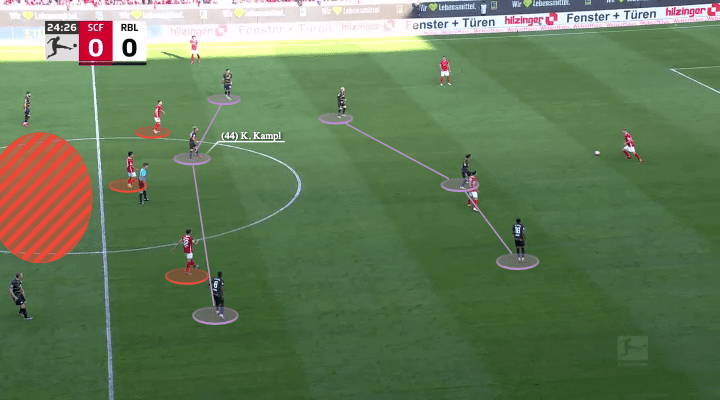
Although Marsch’s defensive philosophy is ball-oriented with concepts of man-marking, the issue of the back four was the subject of space. In a 4-3-3, the first line was often stretched by the build-up (both vertically and horizontally) and the midfielders were detached, giving them difficulties to execute the trap and recover possession. Also, with two central defenders at the back only, they were afraid to step up and close spaces behind the midfield, which resulted in losing compactness in the defensive organization.
For example, in the above situation, Friberg had three players appearing behind the second line, and this would fix the Leipzig number six’s attention (Kevin Kampl) and dragged him down. The headache of Leipzig was the red space, when there was a striker to occupy the centre-backs, no one could step up to close that area, and that’s why Kampl must be aware of the players behind instead of going out to press.
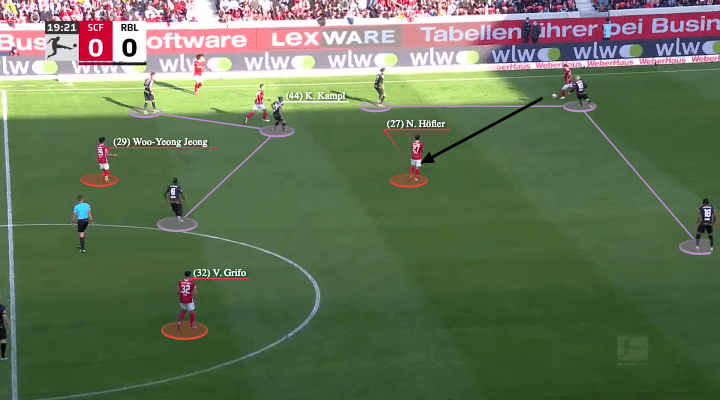
Even the number six of Leipzig could move out of position to press, the defensive structure was still loose as he would be dragged away by other players. The above scenario shows Freiburg using a pair of narrow wingers: Woo-Yeong Jeong and Vincenzo Grifo to fix the second line. And, Kampl already stepped up to close the dropping player wihle Amadou Haidara moved backward to close Jeong.
But Freiburg still managed to break the press by connecting the defensive midfielder (Nicolas Höfler). When the first line was pressing, the far side winger was not staying inside enough to close the midfielder, which you could tell from Christopher Nkunku’s position. Therefore, Höfler remained as the free player to receive between the lines, Leipzig were lacking a player to close that passing option.
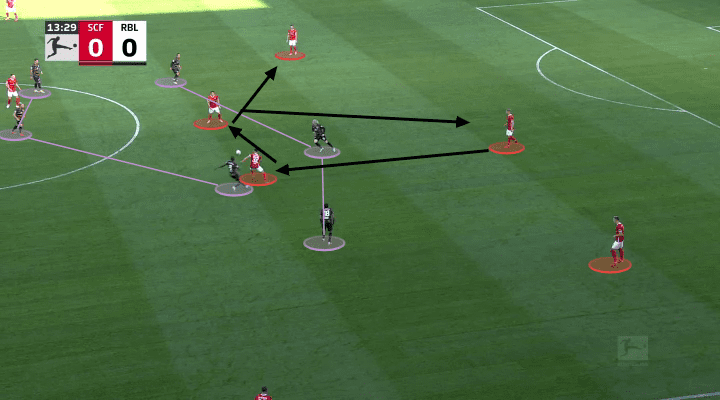
Leipzig also had issues in terms of the control of spacing in a 4-3-3/4-1-2-3. Since the distances of players were relatively large in a midblock, the traps were a bit loose and they let the oppositions escaping before making contacts. Also, given the 4-3-3 was lacking the horizontal coverage, the opposition could first go outside to draw Leipzig out, then, back to the inside to break the press.
The above scenario was a situation of a 4-3-3 vs a 3-2 shape, as the back three took away the front three (Emil Forsberg was dragged away from the midfielder), Leipzig lost coverage of spaces behind the first line. Even Haidara followed the dropping player and came out, he was not supported by Kampl as the former Borussia Dortmund midfielder was fixed by the oppositions behind. Then, the 2v1 overload behind the first line allowed Freiburg to circulate the ball easily, and Leizpig could not catch the flow.
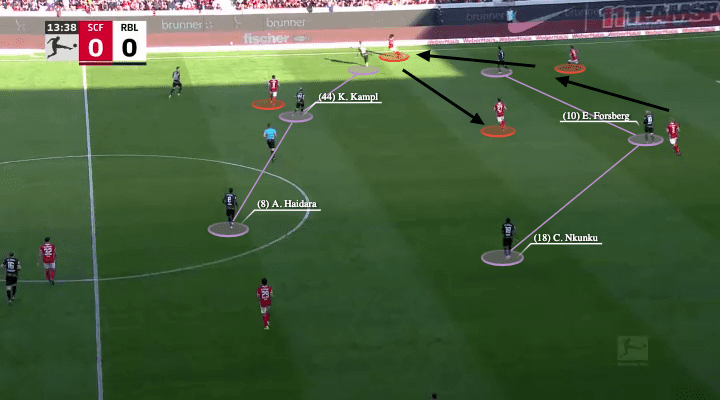
And since Leipzig could not give the oppositions enough pressure, Freiburg very easily moved from the centre to the outside. Then, you could see the problem of the structure. The first and second line were apart as Kampl and Forsberg were dragged away by the opposition, it resulted in a gap in the centre where Höfler could receive. Ideally, the far side winger, Nkunku, should be able to close him but he was a bit out of position in this situation.
Also, when the opposition reached the wide zone, Leipzig could not do a double-press as the first and second line were not close enough. They just gave Freiburg too many spaces to play and let them circulating the ball too easily.
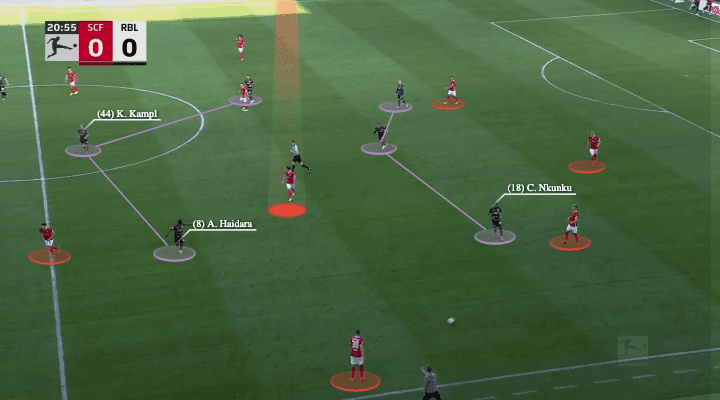
The last image of the section shows the struggles of Leipzig’s 4-3-3 pressing, they could not close the wide zones effectively, especially when the back four are staying in position. Again, the right-winger (Nkunku) was took away by the left centre-back, then who should be responsible on the wing-back? Haidara was isolated without help, as he had the opposition midfielders in the half-spaces, while there was also a runner behind him. In addition, the right-back would be confused by the runner towards him, so he would not step up to close the wing-back. Then, the opposition very easily came out from the flank.
To briefly conclude the issues of Marsch’s back four, you may ponder on the following questions under Leipzig’s contexts: is a first line of three players necessary? How to free the midfielders in the press to execute the trap? And that was related to how to give centre-backs the confidence in terms of closing space. There will be hints and possible solutions in the next section.
3-5-2 as the solution
After Marsch switched to a 3-5-2, they were better with a seven game unbeaten run, including beating Marco Rose’s Dortmund in the recent Bundesliga game. The American coach also used the same shape in the UEFA Champions League clash against Paris Saint-Germain. Although eventually they could not win, the level of the pressing was much better compared to September, the team has made good progress.
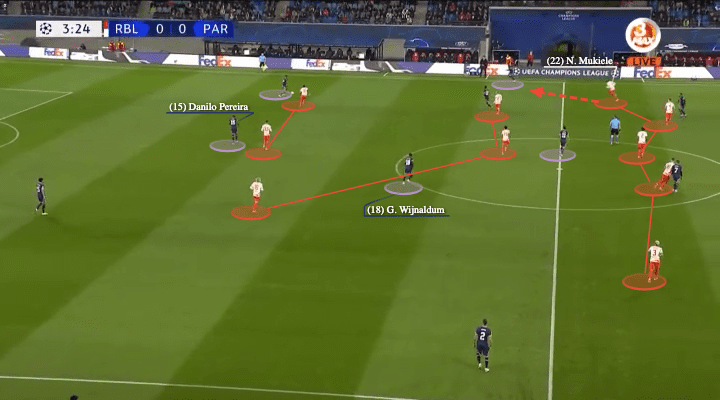
The greatest difference of a 3-5-2 and a 4-3-3 was the number of central defenders, with an additional player at the back, the Leipzig players were braver to step up and press. This gave them more confidence to close the wide spaces while they also had the front five to dominate the central spaces.
PSG dropped Danilo Pereira to form a temporary back three here, but then you could see Leipzig abandoned the far side centre-back as Forsberg swung into the centre. This was important as they abandoned the opposition with a lower chance to receive, something they did not do with a 4-3-3. This allowed the holding midfielder to move up and down as the central coverage was better, such as Tyler Adams could pay attention to Ángel Di María while Forsberg get back to cover Georginio Wijnaldum.
All Leipzig needed was to close the Pereira and Presnel Kimpembe with the first line, then, man-mark the ball side midfielder. When the PSG left-back received, given the sufficient coverage in a 3-5-2, Nordi Mukiele had the courage to step up and close him.
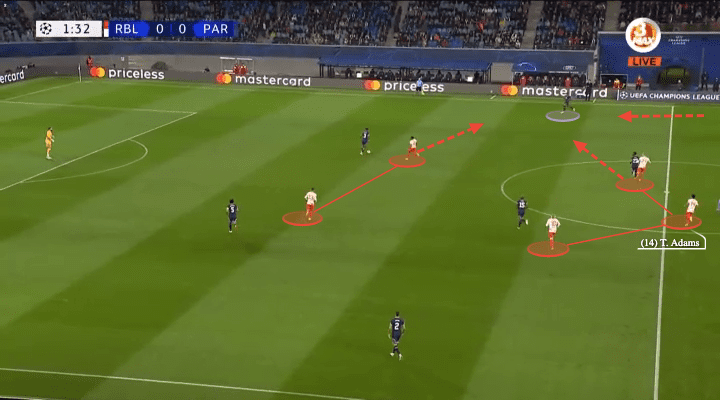
The alternative situation above gives a better idea on how a 3-5-2 could help controlling the wide spaces. PSG did not drop Pereira between the centre-backs this time, so Leipzig just matched the centre-backs with the strikers while trying to shadow the angle towards the centre. Then, they could invite PSG going sideways.
But if Nuno Mendes received, Leipzig had well-prepared solutions to react. It was possible to give Mendes pressure from three angle, including the wide midfielder, wing-back, and the striker. You can see their adjusted positions in the next image. Meanwhile, you could see Adams was a bit deeper as his job was to provide the cover and safeguard the space in front of the centre-backs.
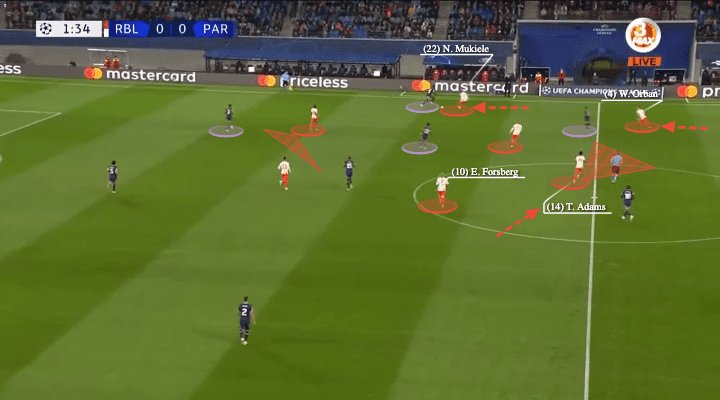
The above scenario was the situation when Mendes received. The players moved accordingly as we have explained, with Nkunku closing the return passing lane, Mukiele coming out to press the receiver vertically. It is a 5-2-1-2 with asymmetrical wing-backs, and on the ball side, everyone should be brave to step up and press, closing the spaces behind the midfield. For example, Willi Orban followed the dropping player to make sure he could not receive freely.
In the centre, you could see Adams moved further backward to provide the defensive cover, while Forsberg and André Silva were in the centre to close the midfielder. The difference between the 3-5-2 and a back four was just the additional player on the ball side, but that one player made a huge difference in the press.
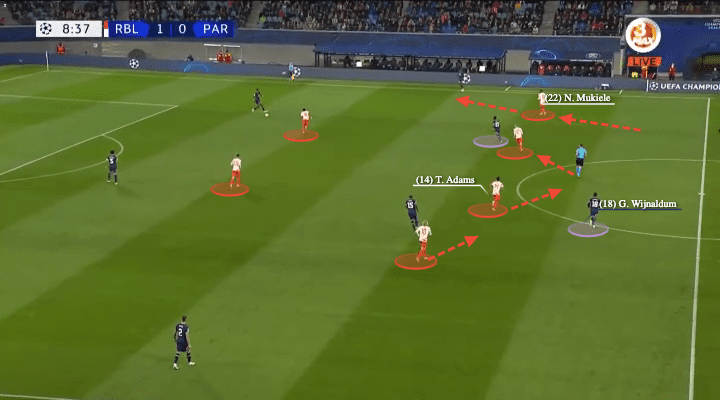
In this example, you could see the way Leipzig swung and how they could close the wide spaces earlier in the opposition half. The first line (two strikers) should always step up to match the centre-backs, while the wing-backs must be high enough to close the opposition full-back in advance. Then, the far side midfielders must go inside to maintain compactness, which allowed the ball side midfielder to come out to press the dropping player (Konrad Laimer on Idrissa Gueye).
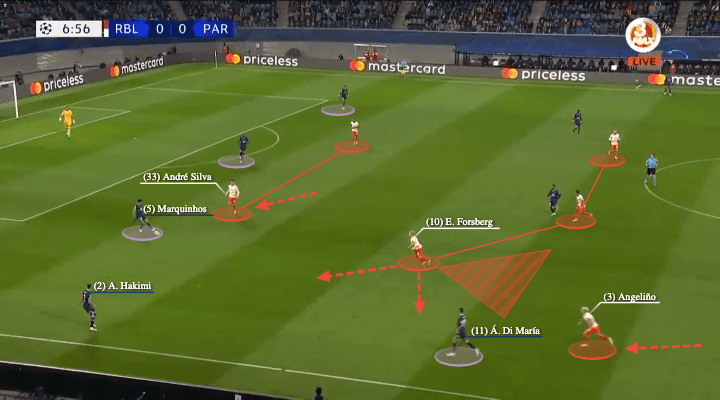
The switch of formation also helped Leipzig to better execute the pressing traps, which was a very important aspect of Marsch’s football philosophy. In the above image, PSG played with a temporary back three again as Pereira dropped deep, but Leipzig did not match the line of three numerically. Instead, they just moved the striker from one side to the other to invite the oppositions to one flank, see the angle of Silva to close Marquinhos.
One thing Leipzig did well was to close the half-spaces. Although Di María and Achraf Hakimi were both in the wide zones, Forsberg did not let them to take him out. Instead, the Swedish international remained in the centre to block that channel, which made sure the opposition would go wide. Then, they had the left wing-back (Angeliño) to close the receiver, and Silva stayed around Marquinhos to close the return pass. PSG fell into this side trap and lost the ball on this occasion.
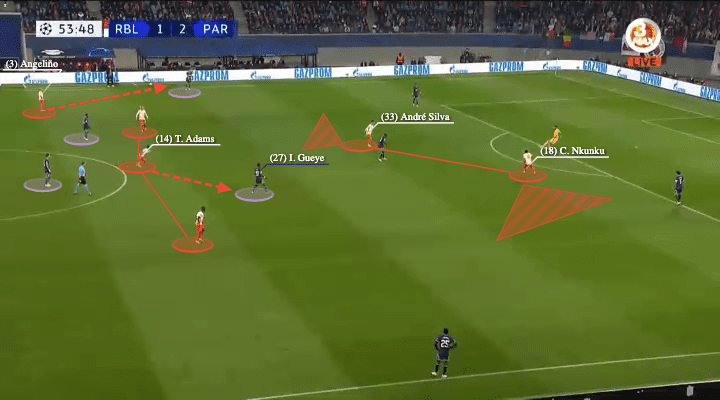
The 3-5-2 also gave Leipzig’s number six more freedom to join the press, as they knew there were three central defenders at the back, there should be sufficient coverage to close spaces behind the midfield. In this case above, Leipzig set the midblock and used the body orientations of strikers to block the outside channel. On the left side, they had Angeliño lurking on Hakimi. So, Gianluigi Donnarumma was invited to play centrally to the dropping Gueye. But this time, Adams stepped up to press despite there were multiple players behind the midfield, as he knew there were enough centre-backs to close that space.
Conclusion
In this analysis, we did not go into the details in the offensive organization of Leipzig, as the formation was not the decisive factor in that phase. Regardless of the formation they used, Marsch’s troops played with the same principles and they also created the chances through the offensive transitions. The main point of this analysis is to show the differences in Marsch’s back four and 3-5-2, and how that facilitated a better space control when the team was out of possession. Nevertheless, the players, especially the individual defending of centre-backs must keep improving so they give Marsch a greater flexibility to adjust his tactics, currently the likes of Mohamed Simakan were not too comfortable in defending spaces.





Comments